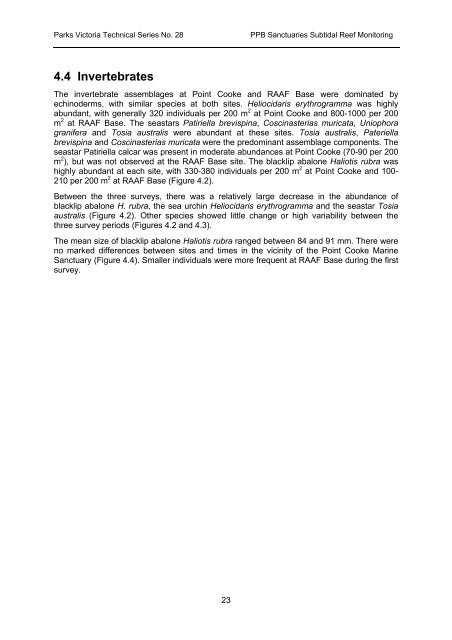Victorian Subtidal Reef Monitoring Program - Parks Victoria
Victorian Subtidal Reef Monitoring Program - Parks Victoria
Victorian Subtidal Reef Monitoring Program - Parks Victoria
Create successful ePaper yourself
Turn your PDF publications into a flip-book with our unique Google optimized e-Paper software.
<strong>Parks</strong> <strong>Victoria</strong> Technical Series No. 28PPB Sanctuaries <strong>Subtidal</strong> <strong>Reef</strong> <strong>Monitoring</strong>4.4 InvertebratesThe invertebrate assemblages at Point Cooke and RAAF Base were dominated byechinoderms, with similar species at both sites. Heliocidaris erythrogramma was highlyabundant, with generally 320 individuals per 200 m 2 at Point Cooke and 800-1000 per 200m 2 at RAAF Base. The seastars Patiriella brevispina, Coscinasterias muricata, Uniophoragranifera and Tosia australis were abundant at these sites. Tosia australis, Pateriellabrevispina and Coscinasterias muricata were the predominant assemblage components. Theseastar Patiriella calcar was present in moderate abundances at Point Cooke (70-90 per 200m 2 ), but was not observed at the RAAF Base site. The blacklip abalone Haliotis rubra washighly abundant at each site, with 330-380 individuals per 200 m 2 at Point Cooke and 100-210 per 200 m 2 at RAAF Base (Figure 4.2).Between the three surveys, there was a relatively large decrease in the abundance ofblacklip abalone H. rubra, the sea urchin Heliocidaris erythrogramma and the seastar Tosiaaustralis (Figure 4.2). Other species showed little change or high variability between thethree survey periods (Figures 4.2 and 4.3).The mean size of blacklip abalone Haliotis rubra ranged between 84 and 91 mm. There wereno marked differences between sites and times in the vicinity of the Point Cooke MarineSanctuary (Figure 4.4). Smaller individuals were more frequent at RAAF Base during the firstsurvey.23
















